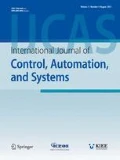Abstract
In this paper, we proposed a new method to improve the dynamic portrait segmentation in Kinect which always causes the problem of incomplete image segmentation of portrait due to the loss of the depth. This problem can be solved by using the color information to reinforce the areas where the depth is uncertain. We can segment the portrait’s foreground more completely using the proposed method. First, the depth information can be divided into foreground, background, uncertain areas to produce a judging area for the foreground’s uncertain areas. Secondly, the volunteer image will be segmented by Sobel edge detection, watershed and other steps in color information then be treated as the characteristic value of color area to calculate the mean value and standard deviation respectively. Finally, we chose the best image from these processing by comparing the color feature of the foreground edge and the judging area. The results show that we can completely segment out the portrait image as well as reduce its error rate significantly.
Similar content being viewed by others
References
A. Ratnaweera, S.-K. Halgamuge, and H.-C. Watson, “Self-organizing hierarchical particle swarm optimizer with time-varying acceleration coefficients,” IEEE Trans. on Evolutionary Computation, vol. 8, no. 3, pp. 240–255, June 2004.
A. Levin, A. Rav-Acha, and D. Lischinski, “Spectral matting,” IEEE Trans. on Pattern Analysis and Machine Intelligence, vol. 30, no. 10, pp. 1699–1712, July 2008.
C. Julià, R. Moreno, D. Puig, and M.-A. Garcia, “Shape-based image segmentation through photometric stereo,” Computer Vision and Image Understanding, vol. 115, no. 1, pp. 91–104, January 2011.
C.-D. Mutto, P. Zanuttigh, and G.-M. Cortelazzo, “Fusion of geometry and color Information for scene segmentation,” IEEE Journal of Selected Topics in Signal Processing, vol. 6, no. 5, pp. 505–521, September 2012.
C.-D. Mutto, P. Zanuttigh, and G.-M. Cortelazzo, “A probabilistic approach to ToF and stereo data fusion,” Proc. of the 3DPVT, Paris, France, pp. 177–202, 2010.
C.-Y. Lee, J.-J. Leou, and H.-H. Hsiao, “Saliencydirected color image segmentation using modified particle swarm optimization,” Signal Processing, vol. 92, no. 1, pp. 1–18, January 2012.
C.-W. Cho, W.-H. Chao, S.-H. Lin, and Y.-Y. Chen, “A vision-based analysis system for gait recognition in patients with Parkinson’s disease,” Expert Systems with Applications, vol. 36, no. 5, pp. 7033–7039, April 2009.
J.-W. Hsieh, C.-H. Chuang, S.-Y. Chen, C.-C. Chen, and K.-C. Fan, “Segmentation of human body parts using deformable triangulation,” IEEE Trans. on Systems, Man, and Cybernetics-Part A: Systems and Humans, vol. 40, no. 3, pp. 596–610, May 2010.
J. MacQueen, “Some methods for classification and analysis of multivariate observations,” Berkeley University of California Press, Proc. of 5-th Berkeley Symposium on Mathematical Statistics and Probability, pp. 281–297, 1967.
J. Tong, J. Zhou, L. Liu, Z. Pan, and H. Yan, “Scanning 3D full human bodies using Kinects,” IEEE Trans. on Visualization and Computer Graphics, vol. 18, no. 4, pp. 643–650, September 2012.
H. Gonzalez-Jorge, B. Riveiro, E. Vazquez-Fernandez, J. Martínez-Sánchez, and P. Arias, “Metrological evaluation of Microsoft Kinect and Asus Xtion sensors,” Measurement, Vol.46, no. 7, pp. 1800–1806, February 2013.
K. Khongkraphan and P. Kaewtrakulpong, “A novel reconstruction and tracking of 3D-articulated human body from 2D point correspondences of a monocular image sequence,” IEICE Trans. on Information and Systems, Vol. E94–D, no. 5, pp. 1090–1098, May 2011.
L. Vincent and P. Soille, “Watersheds in digital spaces: an efficient algorithm based on immersion simulations,” IEEE Trans. on Pattern Analysis and Machine Intelligence, vol. 13, no. 6, pp. 583–598, June 1991.
M. Zollhofer, M. Martinek, G. Greiner, M. Stamminger, and J. Sußmuth, “Automatic reconstruction of personalized avatars from 3D face scans,” Computer Animation and Virtual Worlds, vol. 22, no. 2, pp. 195–202, April 2011.
O. Juan and R. Keriven, “Trimap segmentation for fast and user-friendly alpha matting,” Lecture Notes in Computer Science, vol. 3752, no. 1, pp. 186–197, February 2005.
P. Henry, M. Krainin, E. Herbst, X. Ren, and D. Fox, “RGB-D mapping: using Kinect-style depth cameras for dense 3D modeling of indoor environments,” The International Journal of Robotics Research, vol. 31, no. 5, pp. 647–663, September 2012.
P.-Y Chen, S.-H. Wei, W.-L. Hsieh, J.-R. Cheen, L.-K. Chen, and C.-L. Kao, “Lower limb power rehabilitation (LLPR) using interactive video game for improvement of balance function in older people,” Archives of Gerontology and Geriatrics, vol. 14, no. 107, pp. 677–682, September 2012.
W. Luo, H. Li, G. Liu, and K. NgiNgan, “Global salient information maximization for saliency detection,” Signal Processing: Image Communication, vol. 27, no. 3, pp. 238–248, March 2012.
Z. Liu, W. Li, L. Shen, Z. Han, and Z. Zhang, “Automatic segmentation of focused objects from images with low depth of field,” Pattern Recognition Letters, vol. 31, no. 7, pp. 572–581, May 2010.
Author information
Authors and Affiliations
Corresponding author
Additional information
Recommended by Associate Editor Kang-Hyun Jo under the direction of Editor Euntai Kim.
This journal was supported by the Shantou University, Scientific Research Foundation for Talents plan. The authors deeply acknowledge the financial support from Shantou University, Guangdong, P. R. China under the STU Scientific Research Foundation for Talents plan.
Li-Hong Juang received his B.S. degree in Civil Engineering from the National Chiao Tung University, Taiwan in 1990 and an M.S. degree in Applied Mechanics from the National Taiwan University, Taiwan in 1993, and a Ph.D. degree in Control and Embedded System group from Department of Engineering at Leicester University, UK, in 2006. His research interests are in the analysis, modeling, smart system design, image process, robot control and system biologic control.
Ming-Ni Wu received her Ph.D. degree in Computer Science & Information Engineering, National Chung Cheng University, Taiwan. Her research interests are in image process and information management.
Feng-Mao Tsou received his M.S. degree from the Department of Information Management, National Taichung University of Technology, Taiwan. His research interests is in image process.
Rights and permissions
About this article
Cite this article
Juang, LH., Wu, MN. & Tsou, FM. A dynamic portrait segmentation by merging colors and depth information. Int. J. Control Autom. Syst. 13, 1286–1293 (2015). https://doi.org/10.1007/s12555-014-0313-z
Received:
Revised:
Accepted:
Published:
Issue Date:
DOI: https://doi.org/10.1007/s12555-014-0313-z




